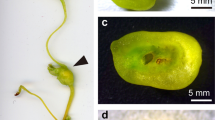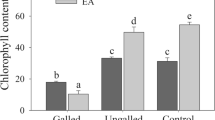Abstract
The chemical composition of galled and ungalled plant tissue was compared in a series of experiments. Gall and adjacent plant tissue was analysed for 20 species of gall-former on 11 different plant species. There were clear differences between galled and ungalled tissue in levels of nutrients and secondary compounds. Gall tissue generally contained lower levels of nitrogen and higher levels of phenolic compounds than ungalled plant tissue. The gall tissue produced by the same plant in response to different species of gall-former differed in chemical composition, as did the gall-tissue from young and mature galls of the same species. The chemical differences between gall and plant tissues were studied in more detail in two field manipulations. Firstly, the seasonal changes in phenolic biosynthesis in Pontania proxima and P. pedunculi (Hymenoptera: Tenthredinidae) gall tissue were compared to those of their host plants, Salix alba and S. caprea. In both types of gall tissue, phenolic levels declined as the season progressed, but levels in the surrounding plant tissue increased. When the gall insects were killed with insecticide, phenolic levels in the galled tissue dropped to the same level as those in adjacent plant tissue. Secondly, the density of Cynips divisa (Hymenoptera: Cynipidae) galls on Quercus robur leaves was reduced by removing half the galls present, either those from the central region of the leaf or those from the edge. Decreasing gall density increased the size of the remaining galls and the weight of the insects, but these effects were most marked when the galls remaining were growing centrally on the leaf, i.e. when the galls from the edge had been removed. Decreasing gall density increased the nitrogen content of the remaining galls, again to a greater extent in galls growing centrally on the leaf. The results of these studies suggest that the levels of nutrients and secondary compounds in gall tissue are usually markedly different to those of surrounding plant tissue, and that gall-formers may produce species-specific and temporally variable changes in the chemical composition of gall tissue.
Similar content being viewed by others
Author information
Authors and Affiliations
Additional information
Received: 7 July 1997 / Accepted: 29 September 1997
Rights and permissions
About this article
Cite this article
Hartley, S. The chemical composition of plant galls: are levels of nutrients and secondary compounds controlled by the gall-former?. Oecologia 113, 492–501 (1998). https://doi.org/10.1007/s004420050401
Issue Date:
DOI: https://doi.org/10.1007/s004420050401




